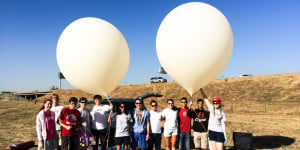
Founded two years ago, the Stanford Student Space Initiative (SSI) has tripled its membership over the past year and is now the largest project-based engineering group on campus, with approximately 100 active members. The group is also widening its focus to incorporate members interested in areas such as space policy and entrepreneurship.
SSI chief marketing officer Kirill Safin ’18 explained that, along with its operations and policy teams, SSI consists of three project groups: rockets, high altitude balloons and satellites – all of which are working on potentially record-breaking projects.
The rockets group hopes to make Stanford the first university to launch a rocket into space (above 100 kilometers in altitude), and the balloons team is aiming to fly a self-monitoring high altitude balloon “space station” across the United States.
The optical communications subgroup of the satellites team hopes to break the terrestrial laser-based-communication distance record by transferring data between two points using lasers and receivers. Laser-based communication would allow for vastly improved data transfer speeds for satellites but needs more development before it can be utilized with technology small and precise enough to operate on a satellite. SSI hopes to work with NASA to continue developing the technology at a nano-scale.
Paul Warren ’17, one of SSI’s newly elected co-presidents, attributes the group’s success to the commitment of its members.
“Our members are putting in five to 10 to 20 or sometimes 30 hours per week into SSI projects, all of which are independent of each other,” Warren said. “We have all of these awesome and amazing engineering projects, and that’s what our strength has been… and that’s what we need to make sure [it] stays at the same level.”
Although SSI has traditionally focused on engineering projects, Warren and Thomas Teisberg ’17, the other co-president of SSI, hope to expand the focus of the group to incorporate a broader range of interests and talents.
“SSI has always been supposed to be more than just a technology group. We see SSI as the group that lets anybody at Stanford act on their interests in space,” Teisberg said. “It’s always going to be our goal to increase the diversity of interests and perspectives that our group encompasses.”
In order to encompass those broader interests, Warren and Teisberg said that they are working on building out the non-technical aspects of SSI. They have especially made an effort to emphasize the importance of space policy and entrepreneurship through their new policy and operations groups.
“We bring in a ton of really interesting speakers from industry, from government, from other universities to do cool talks,” Teisberg said. “In the next year or so, we’ll also be launching a class series on an accessible introduction to space in general, mostly focusing on current space entrepreneurship and space policy.”
One of these speakers was Tory Bruno, the CEO of the United Launch Alliance, whom SSI recently hosted at an event last quarter.
According to Warren, the group hopes to bridge the gap between what he termed “old space” – slow-moving, bureaucratic development of technology in which everything was outdated by the time it was perfected – and “new space” – rapid-fire development of current technologies – with their current efforts.
“SSI aims to bring the entrepreneurial perspective of Silicon Valley to the space industry by training future leaders of the space industry by giving them the hands-on experience they need to succeed,” Warren said.
In addition to broadening the scope of SSI, the group’s leadership hopes to widen its audience and membership base, as well. All of their efforts are a part of a rebranding initiative, which has also involved the creation of an SSI website, the remodeling of mission control (SSI’s construction and meeting room) and the ongoing development of a new logo.
“Even at this point where we’ve grown so much and where so much is being achieved, there is still so much that will happen that the potential within SSI is extraordinary,” Safin said.
Contact Zachary Birnholz at zacharyb ‘at’ stanford.edu.